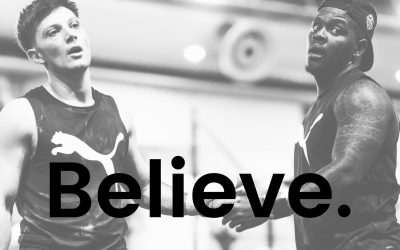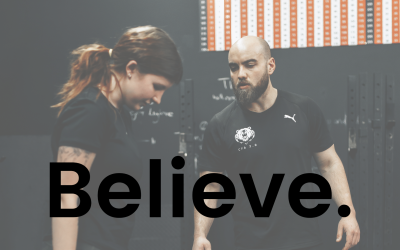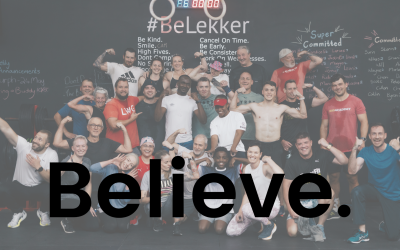It’s a scenario that happens more often than we realise:
You smash a great workout — let’s say there are pull-ups in it — you feel good at the time, but later that day you start to notice some discomfort around your shoulder. Nothing major… just not quite right.
This is a critical moment.
What you do next can either help you heal fast and smart, or set you up for a long, frustrating layoff where things only get worse.

The Common Mistake: Ignoring the Warning Signs
Most people, when they feel a niggle, simply carry on as normal.
They keep pushing through, not adjusting their training, because “it’s not that bad.”
At first, it’s manageable.
But week after week of ignoring the issue often leads to a bigger, deeper injury — one that forces total rest, triggers frustration, and demands months of rehab.
And it’s avoidable.

Our Goal at CrossFit Alberton: Keep You Training (Wisely)
At CrossFit Alberton, we don’t want you to stop training when something feels off.
We want you to keep moving, but with intention — to taper, modify, and adjust so that you can heal while staying active.
Our job is to help you train smart, not just hard. Injuries or niggles aren’t the end — they’re an opportunity to slow down, correct, and come back stronger.

Step 1: Let Your Coach Know
The first and most important step is simple:
Talk to your coach.
You can do this before or after class, or even better, during the wellness check at the start of class when your coach asks, “Are there any injuries?”
That question is there for a reason — don’t skip it.
Let us know:
- When the discomfort started
- What movements make it worse
- How it feels now
We’re here to help — but we can only help if we know what’s going on.
Step 2: Modify Training Smartly
Once you’ve spoken to a coach:
- We’ll help you scale the workout to reduce stress on the irritated area.
- We’ll choose alternative movements that allow you to get blood flow and maintain fitness without making things worse.
- We’ll monitor how it feels during and after sessions to guide your progression.
Remember:
Training through an injury smartly is active — not passive.
You don’t just “do less” — you do the right things.
Step 3: Follow a Proper Recovery Pathway
Here’s the simple injury recovery progression based on the latest research (the PEACE & LOVE model):
Phase 1: Settle the Irritation
- Reduce aggravating movements — don’t push through sharp or persistent pain.
- Stay active with modified, pain-free exercises to keep blood flow moving.
- Ice can be used for pain relief if needed (optional — it doesn’t speed up healing).
- Gentle mobility and range of motion work are encouraged, as long as it doesn’t cause pain.
- Important: If the pain is severe or not improving after a few days, seek help.
Go see a physio or your doctor. We have some awesome physios we work with — please ask one of the coaches for a referral.
Phase 2: Restore Stability
- Begin light activation exercises like:
- Isometrics
- Band work
- Core control drills
- Keep movements slow and controlled — no sudden, loaded movements.
- Focus on rebuilding joint control and confidence.
Phase 3: Strengthen the Area
- Progressively reload the injured area in a controlled, gradual way.
- Strengthen surrounding muscles to support long-term resilience.
- Reintroduce patterns like pushing, pulling, squatting, or hinging with intention.
Phase 4: Return to Full Movement (and Fix the Root Cause)
- Don’t just “go back to normal” when the pain is gone. That’s often when injuries come back.
- Fix the original issue — whether it’s a movement pattern, strength imbalance, or mobility restriction.
- Stay consistent with your prehab work, even after you’re back in full training.
- This phase may require the help of a biokineticist to assess and correct underlying imbalances.
- If you don’t have a trusted Bio, ask one of the coaches — we’ll refer you to someone we trust who understands how we train at CrossFit Alberton.
Step 4: Use Group Classes Wisely
Group classes follow general programming — but your recovery needs specific tweaks.
- Talk to your coach at the start of every class.
- Ask for movement substitutions that won’t aggravate the injury.
- Choose movements that challenge you safely.
- Focus on quality: This is your chance to improve movement patterns and mechanics.
Scaling is not a step backward — it’s a smart step forward.
Step 5: Get Outside Help If Needed
Sometimes, despite smart scaling and coaching support, an issue needs professional attention.
We are not doctors or physios.
We can modify your workouts, but we don’t diagnose or treat injuries.
If you’re not improving, or if something feels sharp, deep, or persistent, it’s time to book with a physio or biokineticist.
We’ve got a trusted list of professionals we work closely with who:
- Understand how we train at CrossFit Alberton
- Know how to support athletes through recovery
- Believe in movement as medicine
Just ask — we’re happy to refer you.

Final Thoughts: Don’t Panic — Get Smart
Pain and injuries aren’t a death sentence for your training.
They’re just messages from your body — and if you listen early, you can stay in the game and even come back better than before.
So if you feel a niggle:
- Speak up.
- Scale wisely.
- Stay moving.
- Get help early.
- Fix the root cause.
You don’t need to train less — you just need to train smarter.
Quick Recap: What To Do When You Feel a Niggle
| Situation | Action |
|---|---|
| Slight Discomfort After Training | Tell your coach (before/after class or during wellness check) |
| Pain with Certain Movements | Modify/taper your workouts |
| Pain Not Improving After a Few Days | See a trusted physio/biokineticist |
| Pain-Free | Begin strengthening and fix the root cause |
Need Help Now?
If you’re feeling something isn’t right, please speak to a coach.
We’ll help you scale smartly and, if needed, connect you with a physio or bio who’ll help you get back to full training safely.
We’ve got your back.
#BeLekker
#TrainSmart
#WeAreCFA



